by Dan Blank (@DanBlank)
There are lots of people online offering advice for writers, and it becomes clear pretty quickly that there are vast differences between these people. Dan Blank, today’s guest author, is clearly at the top, one of the best coaches for authors online. Dan’s also an accomplished blogger, and his video interviews with dozens of publishing insiders are required watching. Today Dan turns to a thorny subject for many self-published writers who are marketing online: using analytics to answer some basic questions about your readers.
Many writers I speak to often mention these two challenges:
- Not knowing enough about who their audience is.
- Not having enough time to do everything they want to develop their author platform.
Today, I want to address both of those concerns showing you how analytics can be used to help answer these questions.
Now, I am not some person who loves spreadsheets, and you don’t have to be either. Many writers I know aren’t too fond of combing through data, and I don’t blame them.
But… there are some powerful tools out there that can tell you more about what engages your audience, what channels work best to grow your community, and where you should be spending more of your time to increase the return on investment of your precious resources. So please, don’t think of the numbers we discuss in analytics as “data,” think of these numbers as representing the intentions and behaviors of those you are hoping to reach and engage.
The goal here is to glean insight from data, and to turn that insight into action. To use tools to tell us something meaningful—such as which topics you should blog about—and then take a simple action to improve your author platform, such as writing more posts about that topic.
Nowadays, we all have more tasks to do than hours in a day. So you have to focus not on “doing more,” but doing more of what works, and less of what doesn’t. Working smarter, not working harder.
Two Tools that Can Help Authors
To frame the discussion today, I will be referencing two tools:
- Google Analytics for website analytics.
- Hootsuite for social media analytics.
Each of these tools is free, and each is representative of many other similar analytics packages. The key lessons here today are about establishing a process for learning more about your audience, a process that you can leverage across many tools.
And before you shrug away the value of analytics, consider this: how can you improve what you don’t measure? I have seen far too many writers waste unbelievable amounts of time pursuing strategies to grow their audiences that “felt” right, but were completely ineffective.
When you measure performance, you acquire data that allows you to make educated decisions about which strategy is best to reach your goals as a writer.
For the examples below, we will use the assumption that you are an author, one active on social media, and who has a blog on your own website. Joel has spoken frequently about the value of social media and author blogging, and below we will cover three main benefits of using analytics to develop your author platform:
- Who is engaging with you.
- Where they are coming from.
- What they are interested in.
Okay, let’s get started!
Who Is Engaging With You?
Too often, people focus on the wrong side of social media, more on the “media,” and less on the “social.” If you are sharing anything on Twitter, here are three ways to learn who is engaging with you:
1. Hootsuite
I use Hootsuite to manage many of the social networks I engage in. It allows me to create different columns for different purposes. The first column in my dashboard shows me anytime someone mentions me:
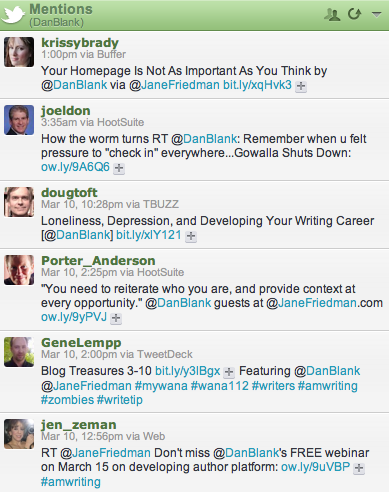
For many of you, this will not be news. But right away, I get insight into the faces, names, background, and interests of those who are most engaged with what I share.
2. Tweetreach
Now, let’s take this a step further. If I do the same search—for my Twitter handle @DanBlank—on a tool such as Tweetreach, suddenly we start getting data around these mentions:
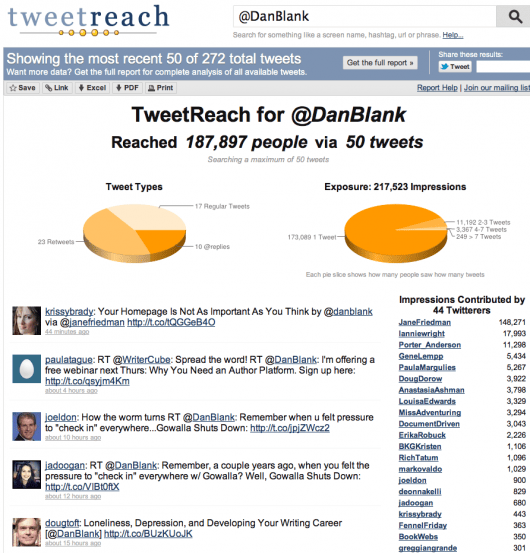
The bottom left of the screenshot above shows you some similar information to what Hootsuite did—those who mentioned me on Twitter. But above that, it provides some data: that via 50 mentions of my Twitter handle, 187,897 people were potentially exposed to my message. I use this example to illustrate the point that data is representative of your audiences’ intentions and behaviors.
On the Tweetreach screenshot, you can see they also provide a list of those who mentioned me, ordered by the size of their Twitter following, and multiplied out by the number of times they mentioned me (or something like that!).
So, if I am wondering who my audience is on social media, and which of those people are most engaged, Hootsuite and Tweetreach just gave me a lot of insight from which I can then consider further actions from.
For instance, do I reach out to these people and thank them, to perhaps guest post on their blogs (as I’m doing here on Joel’s blog), or to show them how much I listen and spread THEIR messages? Again: data should lead to insight which should lead to action.
3. SocialBro
What else can we learn about our audience? SocialBro is another social analytics package that tells you quite a bit of information about those you engage with on Twitter. In the example below, SocialBro analyzed those I follow, and came up with recommendations for the best times for me to Tweet—the times my audience is most active on Twitter:
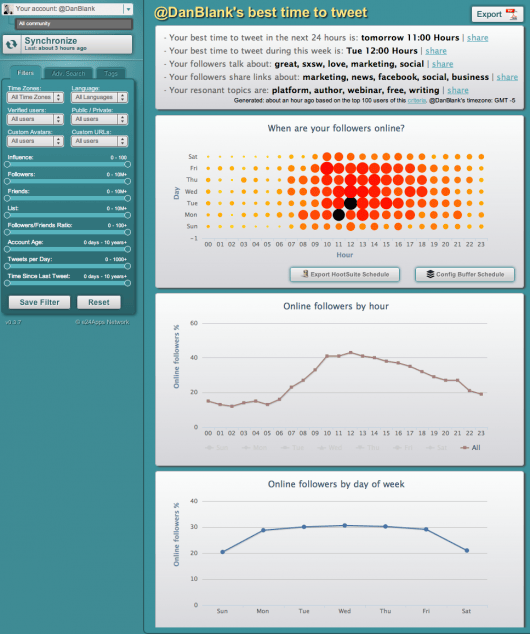
With all of this information, you can slowly optimize how you use social media, who you focus your attention on, and changing your behavior as to when you share content in order to improve engagement, encourage your messages to spread further, and growing your audience.
Where Your Audience is Coming From
Now we move into web analytics. If you blog, you will want to know which topics are most interesting to your existing readership. Even if you have only a small audience, it is critical that you learn more about what engages them, and strengthen that connection.
Once you have a core group of fans you engage with, you will find that your message spreads more easily beyond them.
If you blog, you can use Google Analytics to tell you where your audience comes from:
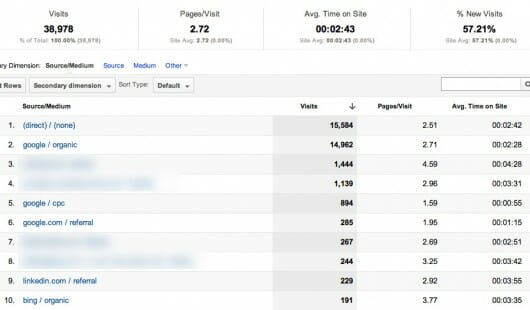
This is a basic report, we could dig in much more deeply. But as you comb through the networks, right away, you can see which sources bring people to your blog. Perhaps one social network will be wildly more influential than another, indicating that you may want to redouble efforts there.
As you go further into the list, you may discover individual bloggers who are sending you traffic, in which case you would want to check out their sites, and reach out to them.
For search traffic, Google Analytics will tell you the specific keywords people typed into Google that resulted in them landing on your blog. You can track the effectiveness of your newsletter and any other ways you may be trying to engage your readership.
If you share links to the same blog post across multiple social media platforms, you can tag each link so that you can measure which platform delivered a larger and more engaged readership.
By adding just three things to the end of a URL, you can tag it by medium (such as social media, email, etc.), source (such as Facebook, Twitter, a newsletter, etc.), and campaign (perhaps you were promoting a specific offer for a discount on your ebook.)
Google has a wonderful URL Builder tool that makes this easy. This is what it looks like, and here is an example of a modified URL:
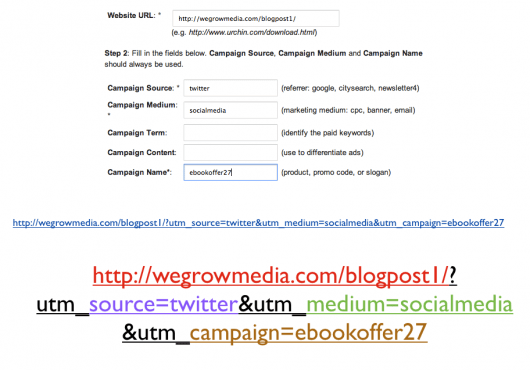
What this means is that when I log into Google Analytics, I can more easily track which source performed better than others.
What Your Audience is Interested In
Analytics also tells you what people were most interested in. Like many bloggers, every piece of content I share takes effort, and I had a strong feeling that it would engage my readership. And yet, invariably, some blog posts spread to a large audience, while others fail to engage.
Analytics tell me which do well, and helps me frame my editorial calendar for the future based on actual audience behavior, not just my own guesses.
Google Analytics makes this easy, with just a couple of clicks. Here are some of my most popular pages on my blog:
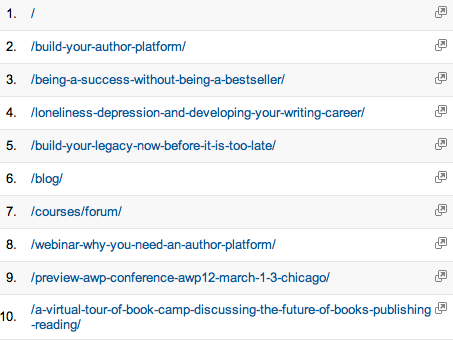
Some of this is surprising, and some isn’t. But a few noticeable things jump out at me, and allow me to focus on taking action from this data:
- A blog post I wrote a couple weeks back is still very popular. Perhaps I should revisit that topic again in an upcoming blog post, it clearly resonated with people.
- I wrote two posts back to back, one about loneliness, depression, and your writing career, and another about what writers can learn from weight watchers in developing their author platform. The latter didn’t even make it to the top 10 posts for this time period. I can take several possible actions here: reevaluate my efforts to spread the post referencing weight watchers; or perhaps to continue addressing the topic of depression and writing.
- Posts I wrote about publishing events did very well. But the key will be to gauge if the short term value of these posts warranted the effort involved to create them. The other content I share is much more evergreen.
For each of these, there isn’t a clear answer, but looking at the analytics allows me to react to what DID happen, not just what I HOPED would happen.
There are many other ways to get even more insight into who your audience is, where they come from, and what they are interested in. But I hope this primer on how analytics can help shape your author platform was a first step in you learning more about your readership.
 Dan Blank is the founder of WeGrowMedia, which provides writers and publishers the strategy and tactics they need to impact their communities and build their legacies. He has worked with more than 500 writers, a wide range of publishers, and regularly speaks at conferences about branding, content strategy, social media, and marketing. He teaches an 8-week online course for writers called Build Your Author Platform. You can follow him on Twitter at @DanBlank and read his blog at https://WeGrowMedia.com
Dan Blank is the founder of WeGrowMedia, which provides writers and publishers the strategy and tactics they need to impact their communities and build their legacies. He has worked with more than 500 writers, a wide range of publishers, and regularly speaks at conferences about branding, content strategy, social media, and marketing. He teaches an 8-week online course for writers called Build Your Author Platform. You can follow him on Twitter at @DanBlank and read his blog at https://WeGrowMedia.com
Blog header photo by Oakley Originals



